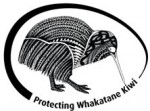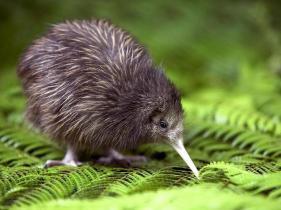
For more information about the Whakatane Kiwi please visit www.whakatanekiwi.org.nz
Click here to see where Kiwi live in Whakatane
Whakatāne is regarded as the 'Kiwi Capital of the World'.
Kiwi hold a special place in the hearts of New Zealanders. The flightless, intriguing native bird is a national icon and many New Zealanders refer to themselves as Kiwis. The Kiwi is a taonga (treasure) to tangata whenua (Maori, the people of the land), who have strong cultural, spiritual and historic associations with Kiwi. Kiwi are largely nocturnal birds (active at night) and are flightless, with only small wings and a small tail. They have an exceptional sense of smell and their nostrils are uniquely placed near the tip of the long bill.
More Information
 Just five percent of kiwi chicks in the wild make it to adulthood. Most kiwi chicks are killed by predators including stoats, ferrets, dogs and cats. Possums don’t kill kiwi but compete for nest sites, fight with kiwi and sometimes the eggs get smashed.
Just five percent of kiwi chicks in the wild make it to adulthood. Most kiwi chicks are killed by predators including stoats, ferrets, dogs and cats. Possums don’t kill kiwi but compete for nest sites, fight with kiwi and sometimes the eggs get smashed.
There are five species of kiwi – North Island brown kiwi, little spotted kiwi, great spotted kiwi (roroa), Okarito brown kiwi (rowi), tokoeka. All are classified as threatened species.The kiwi living in the Whakatane district are the North Island brown kiwi (Apteryx mantelli). The North Island brown kiwi is classified as in serious decline - at an alarming rate of around six percent each year. There is estimated to be 25,000 North Island brown kiwi remaining in Northland, Coromandel, Bay of Plenty, East Coast, Hawkes Bay King Country, Taranaki, and Wanganui. The Whakatane kiwi are the eastern race of North Island brown kiwi of which there are estimated to be only 8000 remaining.
With help from the Whakatane Kiwi Trust, the Whakatane Kiwi Project, and the community, kiwi in the Whakatane district are prospering.
Kiwi in our Backyard
In the Whakatane district kiwi are literally in our backyard and we have the unique opportunity to be able to walk off the pavement into the bush and be in kiwi territory. Kiwi calling can be heard from the CBD. Those who live adjacent to the reserves may even have kiwi forage in their garden. There is no other large urban centre that has kiwi in such close proximity.
Click here to see where Kiwi live in Whakatane
The Whakatane Kiwi Project currently works on reserve lands including Moutohora (Whale Island), Ohope Scenic Reserve, Kohi Point Scenic Reserve, Mokorua Scenic Reserve and Waiotane Reserve (Wainui).
The success of this project has been spectacular in terms of the rate of recovery of the kiwi population in the district, and is unparalleled elsewhere in New Zealand. Whakatane Kiwi Trust and its partners plan to continue and expand kiwi protection work in the Whakatane district…and they need your help.
The Whakatane Kiwi Project
In 1999 a few North Island brown kiwi were discovered in Ohope Scenic Reserve, southeast of Whakatane and south of Ohope. Miraculously, adult kiwi had survived in the reserve without any predator control.
The discovery initiated the Whakatane Kiwi Project, a partnership between Environment Bay of Plenty and Department of Conservation, in conjunction with Te Runanga o Ngati Awa. Te Runanga o Ngati Awa are joint managers of Moutohora and Ohope Scenic Reserve and also hold statutory acknowledgement rights over Kohi Point and Mokorua Scenic Reserves.
Since then, targeted predator control and Operation Nest EggTM have gone a long way to achieving a self-sustaining kiwi population in Ohope Scenic Reserve and Moutohora (Whale Island) and expansion of management into other areas. There are now more than 100 kiwi under management in the Whakatane are
For more information about the Whakatane Kiwi please visit www.whakatanekiwi.org.nz

